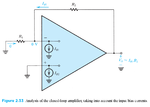CHL
Member level 3
Hello
When we consider an input bias current of an opamp, it is constant.
For example, if there is a simple inverting amplifier without an input signal, the output voltage will be the input bias current x the feedback resistor, and the output voltage only depends on the feedback resistor.
Why is the input bias current constant?
Why isn't it affected by the resistor or input impedance?
For JFET input opamps, the reverse biased pn junctions of the input FET provide almost constant currents.
However, I don't understand BJT and MOS based opamps.
When we consider an input bias current of an opamp, it is constant.
For example, if there is a simple inverting amplifier without an input signal, the output voltage will be the input bias current x the feedback resistor, and the output voltage only depends on the feedback resistor.
Why is the input bias current constant?
Why isn't it affected by the resistor or input impedance?
For JFET input opamps, the reverse biased pn junctions of the input FET provide almost constant currents.
However, I don't understand BJT and MOS based opamps.
